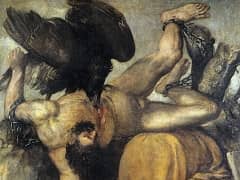Venus Blindfolding Cupid, 1565 by Titian

In old inventories, the figures in this painting are identified as either the Three Graces or Venus and two nymphs. In fact, the work depicts Venus blindfolding Cupid, the little god of love,
and two nymphs who bring Cupid's bow and arrows. The painting evokes Cupid's blind power as his mother, the cosmic divinity, blindfolds him. His brother is intent on observing the large
number of arrows or fatal darts of love (a metaphor for amorous glances) the nymph is carrying.
This entire painting is covered by a unified golden red shade that is particularly apparent in the colour of the sky. The colour scheme is completed by an economical use of blues and greens.
Titian decided not to use the powerful, impasto highlights that are such a frequent feature of his works during the 1550s. The painting, in spite of the potentially joyous mythological
subject and similarly to other works executed in this period, is pervaded with a degree of tension which is clearly evident in the sad and pensive expressions and in the intense colours
of the fiery sky.
The rapid brush-strokes of Titian's mature pictorial technique when seen close to seem to break up the forms but from a distance they acquire an extraordinary modelled quality and create a
chromatic texture that blends the background and figures in a `Venetian' harmony of colours. In the 17th century this style influenced
Diego Velazquez, Peter Paul Rubens, van Dyck and Caravaggio.















